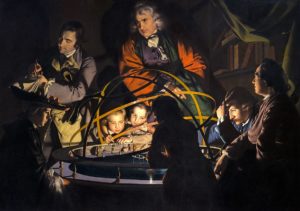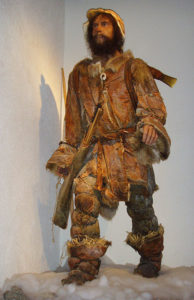 Otzi The Iceman
Otzi The Iceman
As it happens, we have wonderful evidence of how people lived in the old days. It has taught us a great deal about people in the ancient era. The discovery happened like this:
In September of 1991, two German tourists from Nuremberg took a hike through the high Alps on the Austria-Italy border. This was late summer, when the snow atop these mountains was at its minimum, making hikes in the area not overly difficult. As they crested the mountains, the two hikers stumbled over the mummy (naturally mummified, not wrapped in bandages) of a man who had died some 5,300 years earlier… at about 3,300 B.C. His body was enclosed in ice, along with things he had been carrying.
This man is now referred to as Ötzi or The Iceman, and he has been very carefully examined by scientists. Here’s what the scientists found:
-
- Otzi was approximately 5′ 5” tall.
-
- He weighed about 110 pounds.
-
- He was about 45 years old.
-
- He spent his childhood near the present village of Feldthurns, in what is now extreme northern Italy, then moved to a valley 30 miles to the north of that. (Believe it or not, this can be determined by analyzing pollen and tooth enamel.)
-
- His lungs were blackened, probably from breathing the smoke of campfires.
-
- His last two meals included venison, antelope, wheat bread and fruit.
-
- He was carrying wheat, barley, berries, birch baskets, mushrooms and a variety of seeds.
-
- He was carrying a birch fungus that is known to have antibacterial properties.
-
- The wheat and seeds he carried had been stored for months, prior to his last trip across the Alps.
-
- He had an axe that was made of 99.7% pure copper. It was apparently made with the lost wax process; a process that is still used for casting sculptures.
-
- Wear on his bones indicates that he traveled frequently and far.
-
- He had been sick three times in the six months before he died. (The disease itself couldn’t be determined.)
-
- He had several tattoos (short, parallel lines) in precisely those places (lower back, knees and ankles) where he would have developed pain due to his strenuous travels. It is possible that these tattoos were related to pain relief treatments, similar to acupressure or acupuncture.
-
- He wore a cloak made of woven grass, a coat, a belt, a pair of leggings, a loincloth and shoes. All of these were made of different types of leather, sewn together with sinew (tendons removed from animals).
-
- He wore a bearskin cap with a leather chin strap.
-
- His shoes were waterproof and wide, designed for walking across the snow; they were constructed using bearskin for the soles, deer hide for the top panels, and a netting made of tree bark. Soft grass went around the foot and in the shoe and functioned like modern socks.
-
- His belt had an attached pouch that contained a scraper, a drill, an awl and dried fungus.
-
- Aside from his axe, he also carried a flint-bladed knife, 14 arrows (some with stabilizing fins), a quiver, bow string, two tools of uncertain purpose, and an unfinished longbow 6 feet in length.
-
- He had a fire starting kit that included pieces of over a dozen different plants, flint and pyrite for making sparks.
Here is a carefully constructed replica of Otzi as he walked across the Alps. (It’s kept at the Museum Bélesta, in Ariège, France.) As you’ll see, he looks a lot like an early American fur trader:
 **
**
Paul Rosenberg
freemansperspective.com
* * * * *
Please take a look at our subscription letters. You can review the back issues here and order here.
